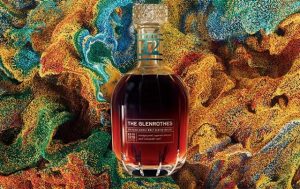These two whiskies form part of the revamped core range from the coastal Highland distillery of Glenglassaugh. The complete brand overhaul includes new packaging and three new whiskies - both are said to be influenced by the land and sea and the vibrant coastal spirit produced at Glenglassaugh. Alongside Portsoy and Sandend is the 12 years old - the first age statement featuring whisky distilled at Glenglassaugh since it reopened after a lengthy closure in 2008. We plan to review this shortly.
The Glenglassaugh distillery is located on the North Sea coast of Aberdeenshire. It was founded in 1875 by James Moir and his nephews, Alexander and William Morrison. The whisky was popular with blending companies and has historically been used in brands such as Famous Grouse and Cutty Sark. The distillery has had an intermittent history with three long periods of closure, the most recent being between 1986 and 2008.
Portsoy uses the distillery's rare peated spirit and is named after the nearby ancient fishing village of Portsoy. It has been matured in ex-bourbon, ex-sherry and ex-Port casks and is bottled at 49.1% ABV. A bottle will cost £60. Both will be available in specialist whisky retailers worldwide.
Our tasting notes
Glenglassaugh Sandend
The colour is straw gold and the nose is sweet and fruity with a hint of salinity. Aromas of honey, vanilla fudge and juicy sultana rise from the glass along with candied lemon, green apple and plenty of tropical fruit - think of pineapple, mango and papaya in particular. There are also hints of white chocolate and toasted nuts.
On the palate this whisky is bright and vibrant with the delicious sweet and fruity notes from the nose continuing. The tropical fruits are right up front now - pineapple, mango, papaya again plus a hint of peach - but are quickly joined by juicy raisin and soft ripe green apple. There is also a hint of cooked pear. Then come honey, vanilla essence and butterscotch. Sitting in the background are some warming woody spices (cinnamon especially), a little drying oak plus something reminiscent of hay or straw and yeasty note that is like freshly baked bread. The finish is long with a distinct apple-like quality drawing it out. This is a very summery and juicy dram.
Glenglassaugh Portsoy
The colour is coppery amber and the nose is packed with aromas of caramel, dried fruits and soft gentle sweet peat smoke. It feels rich and honeyed with warming spices coming through the smoke, along with a hint of cocoa powder and orange oil. The balance between peat and sweetness is very enticing.
On the palate this whisky continues on the rich and honeyed theme. There are plenty of autumnal ripe orchard fruits on show - think apple and pear especially - plus a selection of stone fruits including apricot and plum. The sweet and gentle peat smoke wraps around everything and has a warming edge with a pinch of spice - this is more earthy home fire than bonfire. Hint of chocolate and gingerbread ofurther add to the depth and complexity. The finish is long, well rounded and balanced although a touch ashy towards the end. This feels like an autumnal whisky and a big hug in a glass.
What's the verdict?
We were excited to hear about the Glenglassaugh revamp and are very impressed with both of these whiskies. We cannot wait to sample the 12 years old now. We are also impressed with the packaging redesign which adds a luxurious feel to the brand. This reflects its small capacity and rarity. As for the two whiskies, we liked them both. They push the spirit in differing directions - one juicy, fruity and luscious with the other more rich, moody and smoky - but both work well and are superbly balanced.
We also like that they have been bottled at higher ABV strengths as this seems to really bring out the aromas and flavours to make them pop. The prices are not too naughty either and you seem to get plenty for your money. Big applause all round to Rachel and the team for Sandend and Portsoy, and for giving Glenglassaugh some of the love and attention that the younger liquids deserve.
























